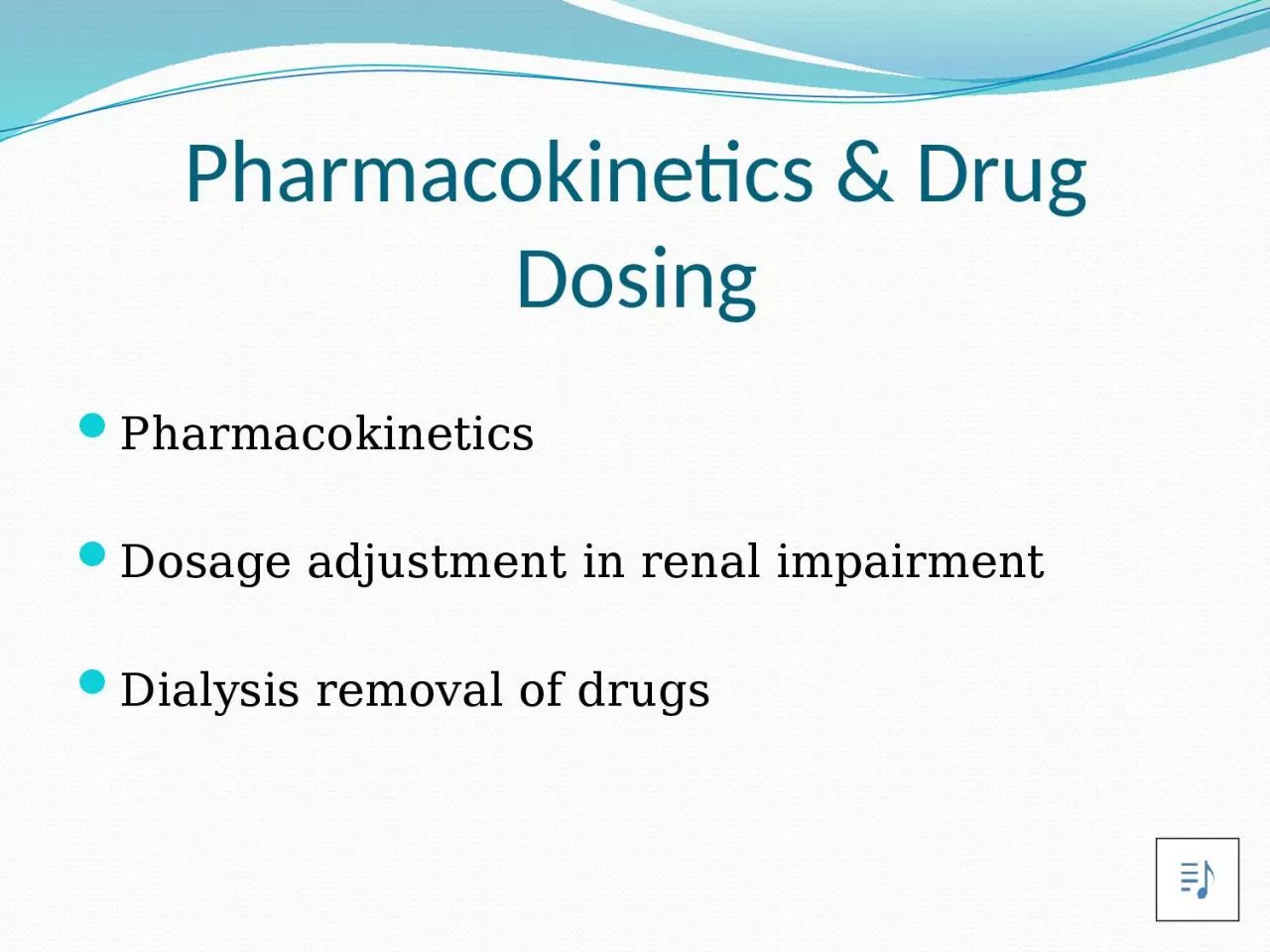

Pharmacokinetics Dosage adjustment in renal impairment Dialysis removal of drugs Ideal drug for a renal patient Nonrenal excretion No side effects Active drug No renally excreted metabolites ID: 931840
Download Presentation The PPT/PDF document "Pharmacokinetics & Drug Dosing" is the property of its rightful owner. Permission is granted to download and print the materials on this web site for personal, non-commercial use only, and to display it on your personal computer provided you do not modify the materials and that you retain all copyright notices contained in the materials. By downloading content from our website, you accept the terms of this agreement.
Slide1
Pharmacokinetics & Drug Dosing
PharmacokineticsDosage adjustment in renal impairmentDialysis removal of drugs
Slide2Ideal drug for a renal patient
Non-renal excretionNo side effectsActive drugNo renally excreted metabolites
Slide3Pharmacokinetics of Renal Failure
BioavailabilityDistributionMetabolismElimination
Dialysis Modality
Slide4Bioavailability
Definition : Amount of active drug in body
Affected by:
Altered gastro-intestinal motility
Increased gastric pH
Uraemia
Other medication e.g. phosphate binders
Slide5Distribution
Altered by:
Hydration – oedema & ascites
Reduced protein binding - malnutrition
Changes in tissue binding
Slide6Protein Binding
Affected by:
pH
Binding inhibitors
Drugs or waste products
Competing drugs
Reduced plasma protein levels
Slide7Metabolism
To convert drugs to more water soluble forms so they can be more easily excretedReduced protein binding means more drug is available for metabolism
Uraemic toxins can induce hepatic enzymes causing an increased metabolism of some drugs
Slide8Elimination Half Life
Definition: Time taken for free drug concentrations to
half
Depends on:
Glomerular filtration
Active tubular excretion
Passive tubular reabsorption
Slide9Drug Dosing
Loading Dose Generally unchanged
Maintenance Dose
General rule - if a drug is normally excreted via the kidneys, its maintenance dose will need to be adjusted in patients with renal impairment.
Slide10Drug Dosing
There are two ways of doing this:-
Increase the dosing interval, dose remains unchanged
Decrease the dose, dosing interval remains unchanged
The objective is to produce a plasma drug profile which approaches that normally achieved in the absence of renal failure
Slide11Dose constant, Dosing Interval increased
Log plasma
concentration
0 1 2 3
Time (days)
------------ Teicoplanin 400mg every 72 hours
_______ Teicoplanin 400mg every 24hours
Slide12Dose reduced, Dosing Interval unchanged
-----------Digoxin 62.5mcg Q 24 hrs
______ Digoxin 250mcg Q 24 hrs
Log plasma concentration
0 1 2 3
Time (days)
Slide13Where to look for Information
BNF ???
SPC
Renal Drug Handbook
Drug Prescribing in Renal Failure: Dosing Guidelines for Adults (Aronoff)
Drug company (remember to prod them!)
Clinical papers (usually case studies!)
SPC’s from other countries
Other colleagues
Slide14Take care with the following drugs
Low therapeutic window
Renally excreted e.g. aminoglycosides, digoxin
Active metabolites which are renally excreted e.g. morphine
Remember to increase doses of drugs as
renal failure improves.
Slide15Drugs to take care with in renal Impairment
Antibiotics especially penicillins and cephalosporins – lower dose is required, neurotoxic. Ciprofloxacin and macrolides cause nausea if the dose is too high. Lower doses with gentamicin and vancomycinAntivirals e.g. aciclovir need to drastically reduce dose otherwise very neurotoxic and will become nauseas
Slide16Biological actions which may be altered in renal failure
Hypovolaemia: enhances antihypertensive effect: antihypertensives – start low dose but increase to maximum dose – Don’t believe the BNF!Uraemia: can cause excess bleeding
Enhanced CNS sensitivity to centrally acting drugs e.g. analgesics especially opiates, antidepressants
Electrolyte variations e.g. digoxin toxicity
Slide17Biological actions which may be altered in renal failure
Hyperkalaemia: enhanced side effects with ACE-I, ARB’s, K+
sparing diuretics & potassium salts
Slide18Removal by intermittent dialysis
Haemodialysis:Surface area, type & permeability of dialyserBlood flow rate
Dialysate flow rate
Duration of dialysis
Drug: M Wt, Protein binding
Peritoneal Dialysis:
Concentration gradient between dialysate & plasma
Peritoneum permeability
Volume & frequency of exchanges
Drug: Vd, Protein binding, renal excretion
Slide19Drugs most likely to be dialysed:
Low molecular weight (HD < 500 Da, HDF < 20,000 Da)
Low protein binding
Small volume of distribution (< 1 Kg/L)
Water soluble
Renally cleared (>50%)
Slide20Removal by CRRT
Vd < 0.7L/kgMolecular weight < 5000 Da Protein binding < 80%Route of excretionUF rateType of dialyserBlood flow rate
Sieving co-efficient (close to 1)
Slide21Comparison of RRT